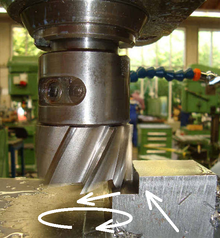Cutting speed

The cutting speed is the speed at which a tool cutting edge is guided through the material to be machined in the cutting direction and thus removes a chip . It is usually given in meters per minute (m / min). Exceptions to this are grinding and some woodworking processes , where the unit used is meters per second (m / s), or angular degrees per 1/1000 of a second .
The cutting speed and feed speed are some of the most important parameters in machining because they have a decisive influence on the production time. Therefore, many manufacturers of machine tools and tools are working on increasing the cutting speed. This resulted in high-speed cutting at extremely high speeds.
The choice of cutting speed essentially depends on the composition and strength of the material to be machined, the toughness and hardness of the cutting material used, as well as the desired dimensional accuracy and surface quality. Due to the parabolic rise in the cutting edge temperature with increasing speed, it has a significant influence on wear and thus the service life of the tool. The cutting speed must therefore be chosen such that a favorable ratio between the working and cutting time and for the reconditioning (change of the indexable insert or Wiederanschärfen) of the tool and Neueinrichten the working machine created time required.
The formula for calculating the cutting speed for a rotating cutting movement (e.g. turning , milling , drilling ) is:
with linear cutting movement (e.g. filing , planing , sawing ):
The formula for calculating the cutting speed when grinding is:
| Cutting speed | m / min or m / s | |
| Workpiece diameter (turning) or tool diameter (milling, drilling, grinding) |
mm (if you turn from 110 mm to 90 mm, you choose 100 mm) |
|
| rotational speed | 1 / min | |
| Workpiece length plus machining allowance | mm |
Web links
swell
- ↑ Carl J. Salomon : Process for processing metals or with processing by cutting tools similarly behaving materials. German Patent No. 523,594 (April 1931.)








